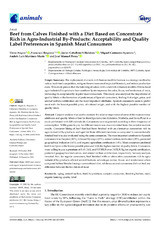Mostrar el registro sencillo del ítem
Beef from Calves Finished with a Diet Based on Concentrate Rich in Agro-Industrial By-Products: Acceptability and Quality Label Preferences in Spanish Meat Consumers
| dc.contributor.author | Angón Sánchez de Pedro, Elena | |
| dc.contributor.author | Requena Domenech, Francisco | |
| dc.contributor.author | Caballero Villalobos, Javier | |
| dc.contributor.author | Cantarero-Aparicio, Miguel | |
| dc.contributor.author | Martínez Marín, Andrés L. | |
| dc.contributor.author | Perea Muñoz, José Manuel | |
| dc.date.accessioned | 2021-12-22T08:41:08Z | |
| dc.date.available | 2021-12-22T08:41:08Z | |
| dc.date.issued | 2021 | |
| dc.identifier.uri | http://hdl.handle.net/10396/22221 | |
| dc.description.abstract | Conjoint analysis was used to estimate the relative importance of some of the main extrinsic attributes and quality labels of beef in three Spanish cities (Córdoba, Marbella, and Santa Pola) in a study performed with 300 individuals. Consumers were segmented according to their frequency of consumption. Willingness to pay for different meats was also calculated from the conjoint analysis results. Consumer liking of beef that had been finished with an alternative concentrate rich in agro-industrial by-products and aged for three different durations as compared to conventionally finished beef was also evaluated using the same consumers. The most important attribute for Spanish consumers was the price (28%), followed by origin (25%), animal welfare certification (19%), protected geographical indication (14%), and organic agriculture certification (14%). Most consumers preferred beef from Spain at the lowest possible price and with the highest number of quality labels. Consumers were willing to pay a premium of 1.49, 3.61, and 5.53 EUR over 14 EUR/kg for organic certification, protected geographical indication, and animal welfare certification, respectively. Sensory analysis revealed that, for regular consumers, beef finished with an alternative concentrate rich in agro-industrial by-products offered several hedonic advantages (color, flavor, and tenderness) when compared to beef finished using a conventional diet, while occasional consumers did not find any difference between the two kinds of meat. | es_ES |
| dc.format.mimetype | application/pdf | es_ES |
| dc.language.iso | eng | es_ES |
| dc.publisher | MDPI | es_ES |
| dc.rights | https://creativecommons.org/licenses/by/4.0/ | es_ES |
| dc.source | Animals 12(1), 6 (2022) | es_ES |
| dc.subject | Aging | es_ES |
| dc.subject | Animal welfare | es_ES |
| dc.subject | Beef | es_ES |
| dc.subject | By-products | es_ES |
| dc.subject | Conjoint | es_ES |
| dc.subject | Consumer | es_ES |
| dc.subject | Finishing heifers | es_ES |
| dc.subject | Meat | es_ES |
| dc.subject | Organic farming | es_ES |
| dc.subject | Quality label | es_ES |
| dc.title | Beef from Calves Finished with a Diet Based on Concentrate Rich in Agro-Industrial By-Products: Acceptability and Quality Label Preferences in Spanish Meat Consumers | es_ES |
| dc.type | info:eu-repo/semantics/article | es_ES |
| dc.relation.publisherversion | https://doi.org/10.3390/ani12010006 | es_ES |
| dc.relation.projectID | Gobierno de España. INALSA IDI-20160001 | es_ES |
| dc.rights.accessRights | info:eu-repo/semantics/openAccess | es_ES |

